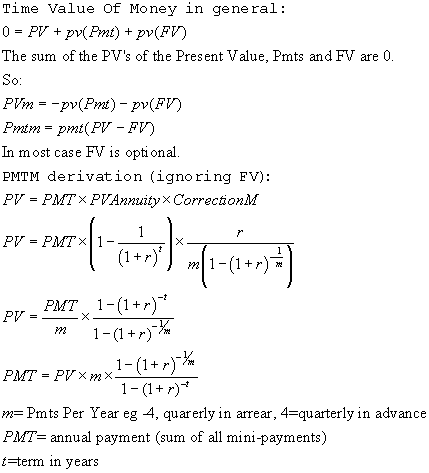| What the name means | "Present Value of an Annuity allowing for different periodicity of payments per year"
| | Syntax | PVM ( AnnPmt, InterestAER, TermYrs, PmtsPerYear, [FVOpt] )
| | Description | Calculates the Net Present Value of a simple annuity, taking into account that the annual payments specified may take place during the course of the year.
| | See Also | FVM (AnnPmt, PresentValue, InterestAER, TermYrs, PmtsPerYear) | | IntRateM (AnnPmt, PresentValue, TermYrs, PmtsPerYear, [FVOpt]) | | PmtM (PresentValue, InterestAER, TermYrs, PmtsPerYear, [FVOpt]) | | PVA (NPVDate, DisAER, AnnualCashFlows, StartAnnDate, [DCountDisc], [StartDCF], [FinishDCF]) | | PVE (NPVDate, DisAER, EvenCashFlows, EvenTimeStart, EvenTimeInterval, [StartDCF], [FinishDCF]) | | PVT (NPVDate, DisAER, Dates, Cashflows, [DayCountDisc], [PrdsDisc], [StartDCF], [FinishDCF], [PVTOptions]) | | TermM (AnnPmt, PresentValue, InterestAER, PmtsPerYear, [FVOpt])
|
| Variable | Type or Value | Description |
|---|
Inputs: (5)
|
| 1
| AnnPmt
| Float
| Annual Payment
|
| 2
| InterestAER
| Float
| Interest Rate expressed as an AER, Annual Equivalent Rate. See Annual Equivalent Rates
|
| 3
| TermYrs
| Float
| Term in years of loan, lease etc
|
| 4
| PmtsPerYear
| Float
| Number of payments Per Year (eg +4 = qtrly in advance, -4 = qtrly in arrear)
|
| 5
| FVOpt
| Float (Optional)
| The future value (optional). FV is the cash balance you would want to attain on the last payment. because of endemic confusion over the sign of FV (we use the same convention as Microsoft), we recommend it is omitted or zero.
(Optional)
|
Output:
|
| Return Value
| PresentValue
| Float
| The Net Present Value
|
Defaults and Values The variable(s) of this function have certain defaults and/or switch values associated with them. Click here to see more. | Type of Value | Value | Description | Detail | | Default(s)
| FVOpt | 0 | Zero future value ie ignore | | Example(s)
| PmtsPerYear | -1 | The usual case for financial functions in general. Payment at the end of the year.
| | | 4 | The usual case for property calculations - rent quarterly in advance.
| | | -4 | The usual case for loan interest, quarterly in arrears. |
Features This function has a few features that help explain its name. Click here to see more. | Feature | What it means | Explanation |
| Compatibility | Compatible with the Blib Library | |
For Excel Experts | | Note that. although similar to the Excel function the order of parameters is different. All the parameters have the same meaning except for PmtsPerYear, which allows for many more permutations that Excel's type argument. Note also that all parameters except FV are mandatory. | Mathematical Formula |  | Methodology | Sign Convention: BF follows Excel's sign convention, which can occasionally cause confusion.
- The PV of a +ve annual payment is -ve.
- The PV of a -ve annual payment is +ve.
- The FV of a +ve annual payment or a +ve PV is -ve.
- The FV of a -ve annual payment or a -ve PV is +ve.
The reason for this is that Excel uses the following equation to calculate PV's:
This is highly logical, but be aware of the apparent swapping in sign, particularly if you are using or solving for FV's, where the confusion gets more pronounced. Sorry about this, but we need to be compatible with Excel! |
Examples | - Preview of the PVM example.
- The above spreadsheet can be accessed from the Quick Reference (on the Business Functions menu), on the Examples menu, or in the Business Functions\Component Examples directory
|
Function Calls This function calls other functions in the Business Functions library. Click here to see more. | Initial Call | Which Calls | Which Calls | Which Calls | | PVOne | | | |
|




